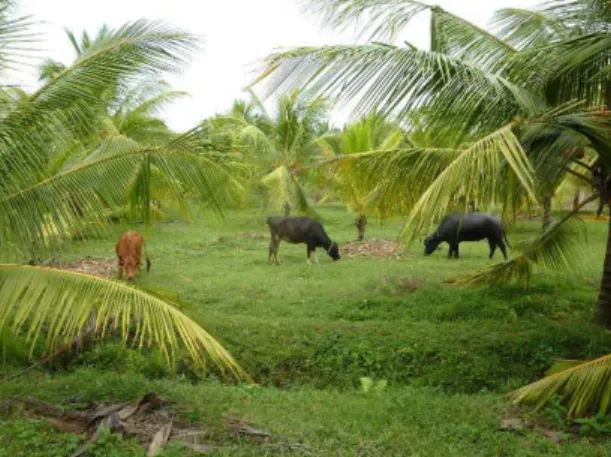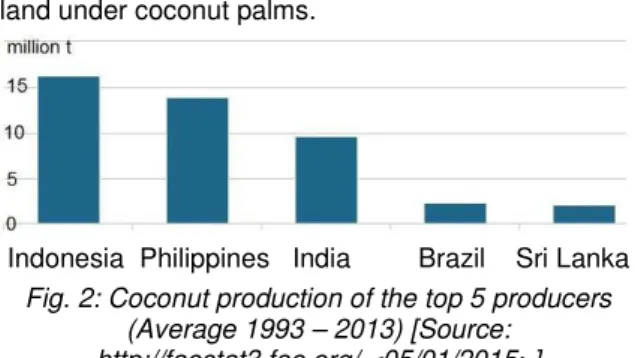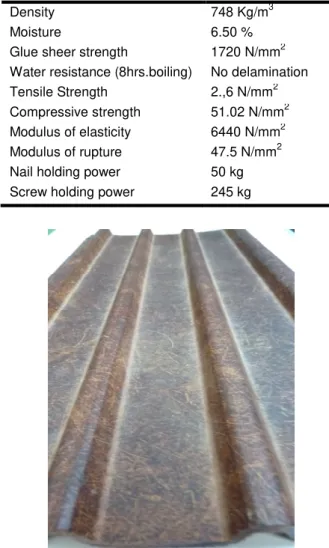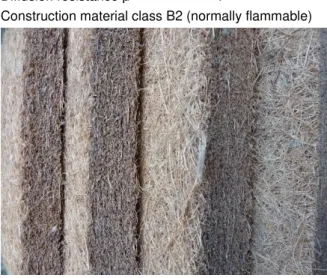First International Conference on Bio-based Building Materials June 22nd - 24th 2015
Clermont-Ferrand, France
COIR - TRADITIONALLY USED FIBRES FOR NEW CONSTRUCTION
APPLICATIONS
E. Kürsten*
University of Applied Sciences and Wood-Report GmbH, 30455 Hannover, Germany *Corresponding author; e-mail: ek@wood-report.de
Abstract
Coir is a byproduct of the production of coconuts. In Europa it has been used for insulation purposes since nearly 100 years. This paper explains where this bio-based material comes from, what building products are being made from it nowadays and why it makes sense to use this resource more intensively in the future even in Europe.
Keywords:
coconut production; coir; fibre processing; coir ply; particle boards; insulation materials
1 INTRODUCTION
On the way to a sustainable future based on renewable resources fibres from tropical countries can be part of the solution. Especially coir, the fibres which are extracted from the husks wrapping the coconut are of special interest because they are available in abundance as a byproduct of the production of copra. Especially in the construction branch there are some possibilities to make much more use of this resource. Thereby, on the one hand adverse impacts on the environment can be reduced, and on the other hand employment and additional income for rural areas in the tropics can be generated.
1 COCONUT PRODUCTION
The origin, biology and importance of the coconut (Cocos nucifera L.) has been described extensively by Prabhakaran Nair [2010]. He explains that “in the state of Kerala, the life of the people is woven around the coconut palm. The endocarp is everyday fare in the kitchen—scrapped or ground to extract the milk and used in all of the culinary specialities of the people. Coconut oil is used for both body massage and for the hair, water from the tender coconut is used as a very nourishing drink, leaves are used for thatching homes, and when dried, coconut is used as firewood.”
Not only the possibilities to make use of the coconut palm are characterized by a great deal of variety, but also the options to mix it with other crops: Even in case of an optimal plant density of 150 - 180 palms/ha plenty of light is available for other vegetation, especially during the first decade after planting and between age 25 and age 70, when the
coconut production finally decreases too much. In the Indian state of Odisha, e.g. “the interspaces are covered with fruit crops like banana, papaya, pineapple and vegetables like okra, bottle gourd and drumstick” [Mohapatra, 2007]. The palm stems can be used to grow climbers like black pepper and betel, and cattle grazing is also widespread under coconut. “There is much evidence in coconut growing countries that coconuts are inter-cropped with other crops thus increasing the productivity of the coconut and of the crops grown under it and thereby increasing potential revenue to smallholders with access to the coconut resource.“ [Warner, 2007]
Fig. 1: Cattle grazing in a young stand of coconut palms in Tamil Nadu (India)
In India, the “Tree of Life” is mainly grown by smallholders with 98% of the holdings of size less than 2 hectares. In the other main coconut producing countries in Asia - Indonesia, Philippines, and Sri Lanka - the situation is similar, with smallholder percentages of the coconut area between 71% and 97% [Arancon 1997]. In total, these four states in
2005 had a share of 76.5% of the world´s 10.6 M ha land under coconut palms.
Indonesia Philippines India Brazil Sri Lanka
Fig. 2: Coconut production of the top 5 producers (Average 1993 – 2013) [Source: http://faostat3.fao.org/ <05/01/2015>]
2 COCONUT PROCESSING
Coconuts are often harvested immature just to use the water inside as a drink. In this case the coir is difficult to collect and process the husks as they become a kind of household waste. Accordingly only husks left over from the production of copra are available for further uses.
2.1 Separation of husks and kernels
At first, the husk has to be separated from kernel either by a cutlass, by a manual dehusker or by a dehusking machine.
Fig. 3: The raw material: Husk of ripe coconut with brown fibres
2.2 Coir processing and fibre qualities
Traditionally in Sri Lanka and in coastal regions of India the husks firstly undergo a retting process, preferable in saline water for some 6 to 12 months to get the fibres more easily seperated. That is often done by beating with wooden sticks. The resulting coir is of a light colour and called ”white fibre”. It is soft and can be spun to yarn which is then used for making various products such as mats, mattings, carpets and rope. White coir therefore is also called ”mat fibre”. The extraction and spinning of white coir fibre is essentially a labour intensive manual process carried out on a cottage industry basis.
For construction purposes only ”brown coir fibre” is applied. Here two types can be distinguished:
• ”Bristle” which comprises of long stiff bristle which is mainly used as filling for the brush industry and more expensive.
• ”Mattress” which are more medium and short fibres which are more soft and mainly used for mattress filling and needlefelt pads of innerspring mattress and upholstery. Both types can also be blended or just not separated. Then they are called mixed brown fibres
(or decorticator fibres) [Ranasinghe 1980]. The production process of the latter has recently been observed in Tamil Nadu (India):
The husks are firstly fed into a crusher with spiked, fluted or grooved rolllers. Then the fibres are sprinkeled with water to start a short retting process of a few hours or days. Thereafter the material is conveyed through a revolving screener where the pith is separated from the fibres. At the end the coir is laid flat to dry in the sun, and then finally baled or twisted to ropes for the transport to the customer. - In general it can be stated that the quantity and quality of coir could be much higher if improved technologies would be more widely applied.
From 1000 coconuts it would be possible to extract 10 kg of coir [FAO 2014].Husks are composed of 70 per cent pith and 30 per cent fibre on a dry weight basis. The ratio of yield of long, medium and short fibre is on average 60:30:10. The average fibre yield can vary: In the south of India and Sri Lanka, for example, where the best quality fibres are produced the average yield is 80-90 g fibre per husk. Caribbean husks, by contrast, are relatively thick and may yield up to 150 g of fibre [van Dam 2002]. Coir fibres measure up to 35 cm in length with a diameter of 12-25 microns [FAO 2014] and have a high content of lignin (about 45%).
Fig.4: Solar drying of coir at the end of the production process.
2.3 Use of residues from coir production and coconut palms for construction purposes
The main byproduct of the coir production is coco peat (pith), a mixture of the non-fibrous paranchymatois “corky” connective tissue linking the fibres, short fibres, and dust. Currently it is mainly used as a soil conditioner. But, as the pith residue contains a relatively high amount of lignin, it could be used as a strong and stable resin-like adhesive to produce coir boards (see 4.2) [van Dam 2004]. The other main type of residues are the nut shells. Like many other organic residues they could be converted to particle boards.
Very special building products from coconut shells are parquet and wall panels developed by the German company IN-PARKETT.
Of course, the lower and outer parts of the trunk of the coconut palm can be converted to sawn timber for construction and flooring. And finally it has to be mentioned that the palm fronds are traditionally used for making walls and roofs of buildings in tropical countries.
3 CONSTRUCTION MATERIALS FROM COIR
3.1 Coir ply
In 2001, in Bhuj (Gurarat / India) 500 shelters were built to aid in the relief from an earthquake. The walls and roofs were made of coir ply and protected from UV rays by weather coat paints, respectively tiles. “The boards having good insulation properties have shown a temperature difference of 5 to 8 degrees when compared to the outside temperature.” In spite of the extreme climatic conditions in Gujarat they are said to remain without defects until today. Coir ply is basically a substitute for plywood, the most popular wood-based panel in India. It is made from coir bonded by a phenol based resin. It is regarded as termite, insect and water resistant [Natureindia 2015].
Tab. 1: Coir ply Test Results (BIS 14842 2000) (Test data as per tests carried out by I.P.I.R.T.I. (Indian Plywood Industries Research & Training
Institute, Bangalore) [Natureindia 2015]
Density 748 Kg/m3
Moisture 6.50 %
Glue sheer strength 1720 N/mm2
Water resistance (8hrs.boiling) No delamination Tensile Strength 2.,6 N/mm2
Compressive strength 51.02 N/mm2
Modulus of elasticity 6440 N/mm2
Modulus of rupture 47.5 N/mm2
Nail holding power 50 kg Screw holding power 245 kg
Fig. 5: Corrugated coir ply (phenol resin bonded coir) as roofing material in Indial
Similar roofing materials which are considered as a low cost alternative to corrugated galvanized iron and asbestos cement sheeting, can also been made from short randomly distributed coir fibres in a cement matrix [Cook 1978].
3.2 Particle boards
Of course, every part of the coconut tree and its fruits theoretically can be used for the production of
particle boards. As in many other countries, in Mexico coir is a generally underutilized material. It has been estimated that about 500 000 t of coir may be available there annually, of which only small quantities are, at present, used to fill car seats and mattresses. – By a preliminary study, the following „optimal“ combination of process variables was found for “pure” coir particle board [Fuentes 1997]:
Single layer, nominal density 0.65 g.cm-3 and 16 mm
thickness; resin content 12%, temperature 150 ºC, pressing time 9 min and pressure 3.5 N mm-2. In addition, combinations of coir and other types of biomass are possible. E.g., in Thailand low-cost insulation particleboards from mixtures of durian peel and coconut coir have been tested. One finding was that a high percentage of lignin content of coconut coir increases the cross-link in particleboards. [Khedari 2004].
The fact that lignin can be used as a natural binding material was the background for the development of a simple and efficient technology to produce boards of high strength and high density from whole coconut husks, without the addition of chemical binders. “The board exhibits excellent properties, which are comparable with or even superior to commercial wood based panels. The pressed coconut husk boards can be handled with common wood working equipment for drilling and sawing, planing and polishing. Screwing, however, is only possible after pre-drilling and the board product is too hard for nailing.” [van Dam 2004]
Fig. 6: Light coir insulation and construction board in India
3.3 Insulation materials
Nature has designed coir as an insulation material for the coconut kernel. The fibres protect the nut against heat from intensive solar radiation and mechanically if it falls to the ground. In addition, the fibres are durable enough to fulfill its tasks even under tropical condition with high humidity and optimal living conditions for insects and fungi. Accordingly, coir has been used successfully for insulation purposes since many decades. The cavity (> 30 µm) in the center of mature fibres [Delft University 2003] is a special advantage for heat and sound protection. In addition, the extremely low decomposition rate makes coir especially suitable for the production of geotextiles [FAO 2014].
Recently in a school in Würzburg (Bavaria) a coir impact sound insulation has been found which remained completely intact since 1934 under a
flooring, and could be reused for the same purpose again. Especially under floorings which have to carry heavy loads (industrial buildings) and where moisture may be a problem coir insulation (eventually with a natural latex impregnation and a density of 160/170 kg/m3) is a perfect solution. [Gittel 2014]
Based on long term experiences with the production of coir mattresses the German company Gittel Triagwerke GmbH recently developed a new type of coir insulation materials for thermal insulation of walls and roofs according to DIN 4108-10. Its technical properties are [Gittel 2014]:
Density ρ 100-130 kg/m3 Thermal conductivity λ 0.042 W/(m . K)
Specific heat capacity c 1,700 J/(kg . K)
Diffusion resistance µ 1
Construction material class B2 (normally flammable)
Fig. 7: Coir mats are extremely well suited for the insulation of the floorings, but also quite an interesting possibility for wall and roof constructions
3.4 Other construction materials
Clay building boards reinforced by coir fibres are available on the market. Coir can also be used for plaster base boards.
4 ECOLOGICAL ASPECTS
An essential ecological advantage of coir is that it is just a byproduct of copra. Therefore no additional land is necessary for its production, in contrast to other natural fibres like hemp, flax, sisal, jute, and abaca. Today less than 25% of the available coir raw materials in the four most important Asian producer countries are being used domestically or in the fibre industry (only in India and Sri Lanka) [van Dam 2002]. Most of the material is just burnt or used as mulch.
In addition, coconuts are rarely grown in large mono cultural plantations. As described above (2.) the prevalent smallholder production of copra in mixed agroforestry systems can be regarded as ecologically (and socially) much more sound than the competing large scale plantation production of oil palms, soybeans and rapeseed (see: [Warner, 2007]). An increased use of coir means a value addition for the coconut growers and provides them with an advantage in their competition with other plant oil producers.
The often mentioned environmental impact of the long distance transport – as compared to locally
grown natural fibres (which would consume additional agricultural land) – is not really important: The consump-tion of primary energy (PE) for transport by a big cargo ship is only 0.0472 kWh/t.km
[Frischknecht 2011]. A calculation with a bulk density of 255 kg/m3 of the bales [Gittel 2014] and a distance
of 12,000 km (from India or Sri Lanka to Germany) results in a PE consumption of 145 kWh/m3 of coir.
The PE consumption for the production of coir is 87 kWh/m3 [Sörensen 1997]. In total 232 kWh/m3 is much less than necessary for production of wood fibre boards and most of the nonrenewable materials (Table 2), even if the different thermal conductivities are taken into consideration.
Table 2: Consumption of primary energy (PE) for the production of different insulation materials [Dorsch
2014]
Origin Material PE-consumption (kWh/m3) Renewable Hemp, Flax 40-80 Wood fibre (flexible) 50-100 Wood fibre (board) 600-1,500 Synthetic EPS 200-760 XPS 450-1,000 PUR 800-1,500 Mineral Bloated perlite 90-160 Rock wool 150-400 Glas wool 250-500 Even though the overall social and environmental impacts of an increased use of the currently completely underutilized potential of coir as fibre resource seem to be positive in countries like India and Sri Lanka, it has to be kept in mind that the situation in the fourth most important producer country seems to be different: In Brazil newly established coconut plantations (sometimes on forest land) are being offered on the global capital market as high quality investment opportunities. “It’s now possible for you to invest today for an immediate annual yield of 12.12% based on current production.” [Simon 2013]
“In the long run two extreme scenarios for plant fibres use can be imagined: either they will foster the development of Third World economy with added advantage for environment at planetary level, or they will be a further natural resource exploited in a "cash crop" philosophy from multinational companies, with negative impact locally and globally.” [Santulli 2005] 5 SUMMARY
Mainly in tropical countries there have been many successful trials to develop construction materials like coir ply, particle board and roofing sheets based on coir.
In Europe, coir has been used as an insulation material for many decades, but firstly due to cheaper materials like rock wool, glass wool, EPC etc., and nowadays due to the developments based on home-grown renewables like hemp, flax and wood fibre it nearly felt into oblivion.
The special properties of coir and the fact that is an underutilized and relatively cheap byproduct of the coconut production are good reasons to bring it back to the minds of European architects and engineers. Against the background of a growing demand for arable land and timber on the one hand, and the need to create more labour and income in tropical countries on the other hand It may even have ecological and social advantages to make a better use of this resource.
6 ACKNOWLEDGMENTS
I want to thank Ramkumar Palanisamy (mpinger GmbH / Germany) and his brother Thigarajan Palanisamy (mp coir / India) very much for the introduction to the processing and use of coir they provided me. I am also very grateful to Mr. Gittel (Gittel Triagwerke GmbH) for sharing his long term experiences with the processing of coir insulation materials with me.
7 REFERENCES
[Arancon 1997] Arancon, R.N.; Asia Pacific Forestry Sector Outlook: Focus On Coconut Wood. Asia-Pacific Forestry Sector Outlook Study, Working Paper Series, Working Paper No: APFSOS/WP/23, FAO, Rome, 1997
[Cook 1978] Cook D.J., Pama, R.P., Weerasingle, H.L.S.D.; Coir fibre reinforced cement as a low cost roofing material. Building and Enviromnent, Vol. 13 (1978), 193-198
[van Dam 2002] van Dam, J.E.G.; Coir Processing Technologies - Improvement of Drying, Softening, Bleaching and Dyeing Coir Fibre/Yarn and Printing Coir Floor Coverings. Common Fund for Commodities. Technical Paper No. 6. Agrotechnological Research Institute (ATO bv), Wageningen,
http://www.fao.org/docrep/005/y3612e/y3612e00.htm #Contents <16/12/2014>
[van Dam 2004] van Dam, J.E.G., van den Oever, M. J.A. , Keijsers, E.R.P.; Production process for high density high performance binderless boards from whole coconut husk. Industrial Crops and Products 20 (2004) 97–101
[Delft University 2003] Delft University of Technology; Composite Applications using Coir Fibres in Sri Lanka. Final Report. Project Number CFC/FIGHF/18FT; This document is available from the FAO Commodities and Trade Division website at http://www.fao.org/es/esc/en /20953/ 21005/highlight_30207en.html
[Dorsch 2014] Dorsch, L., Kaiser, C., Niklasch, W., Schöpgens, H. et al.; Marktübersicht Dämmstoffe aus nachwachsenden Rohstoffen. Fachagentur Nachwachsende Rohstoffe, Gülzow, 6th edition, 2014
[FAO 2014] Food and Agricultural Organisation of the United Nations; Future Fibres. Online: http://www.fao.org/economic/futurefibres/fibres/coir/e n/
[Frischknecht 2011] Frischknecht, R., Stücki, M., Itten, R.; Primärenergiefaktoren von Transportsystemen. ESU-services GmbH, fair consulting in sustainability, CH-8610 Uster, http://www.esu-services.ch/fileadmin/
download/frischknecht-2011-Transportsysteme.pdf <09/01/2015>
[Fuentes 1997] Fuentes, T. F. J.; Silva, G. J. A.; Richter, H. G.; Coconut stem wood and coir (coconut fibre): potential raw materials for particleboard production. Journal of Tropical Forest Products 3(1) (1997), 1-14
[Gittel 2014] Gittel, A.; Personal communication and http://gittel-naturdämmstoffe.de/
[Khedari 2004] Khedari, J., Nankongnaba, N., Hirunlabhb, J., Teekasapb, S.; New low-cost insulation particleboards from mixture of durian peel and coconut coir. Building and Environment 39 (2004), 59 – 65
[Mohapatra 2007] Mohapatra, A.K., Bhola N.,Patnaik R.K.; Agroforestry systems and practices in Orissa. In: S. Puri and P. Panwar, P., eds.; Agroforestry systems and practices. New India Publishing Agency, New Delhi, 333-346
[Natureindia 2015] www.natureindia.com <30/01/2015>
[Prabhakaran Nair 2010] Prabhakaran Nair, P.K.; The Agronomy and Economy of Important Tree Crops of the Developing World. DOI:10.1016/B978-0-12-384677-8.00003, Elsevier Inc., 2010
[Ranasinghe 1980] Ranasinghe, T.K.G.; Coconut processing technology information documents – Part 6 of 7 "Coconut fibre and coir products". Asian and Pacific Coconut Community. UNIDO/IOD.377/Add.5, 1980
[Santulli 2005] Santulli, C.; The environmental and economic impact of using plant fibres for the production of low cost materials in developing countries. MSc dissertation (EDM), Open University, March 2005 (self-published, ISBN 978-1- 4452-6122-5)
[Simon 2013] Simon, L.; Coconut: Immediate cash flow from agriculture. http://www.liefsimon.com/coconuts/ <30/01/2015> [Sörensen 1997] Sörensen, C.; Wärmedämmstoffe im Vergleich. Umweltinstitut München e.V., ISBN 3-930615-13-4, 1997
[Warner, 2007] Warner, B., Quirke, C., Longmore, C.; A review of the future prospects for the world coconut industry and past research in coconut production and product. ACIAR, Canberra (Australia), ISBN 978 1 921434 04 4, 2007



